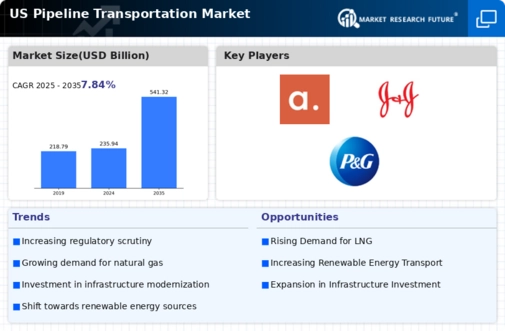Market Consolidation
The pipeline transportation market is experiencing a trend of consolidation, as companies seek to enhance their competitive edge and operational efficiency. Mergers and acquisitions are becoming more common, driven by the need to expand service offerings and geographic reach. This consolidation allows companies to leverage economies of scale, reduce operational costs, and improve service delivery. The pipeline transportation market is likely to see further consolidation in the coming years, as firms aim to adapt to changing market dynamics and regulatory pressures. This trend may lead to a more streamlined industry structure, fostering innovation and improved service standards.
Rising Energy Demand
The increasing energy demand in the US is a primary driver for the pipeline transportation market. As the population grows and industrial activities expand, the need for efficient energy distribution becomes more pronounced. The US Energy Information Administration (EIA) projects that energy consumption will rise by approximately 10% by 2030. This trend necessitates the expansion of pipeline networks to ensure that oil, natural gas, and other energy resources are transported effectively. The pipeline transportation market is positioned to play a pivotal role in meeting this demand, as pipelines offer a cost-effective and reliable means of transporting large volumes of energy over long distances.
Environmental Regulations
The pipeline transportation market is increasingly influenced by stringent environmental regulations aimed at reducing carbon emissions and promoting sustainability. In the US, regulatory bodies are implementing policies that require pipeline operators to adopt greener technologies and practices. For instance, the Environmental Protection Agency (EPA) has introduced guidelines that encourage the use of advanced monitoring systems to detect leaks and minimize environmental impact. Compliance with these regulations is essential for companies operating in the pipeline transportation market, as failure to adhere can result in substantial fines and operational disruptions. Consequently, this regulatory landscape is likely to drive innovation and investment in cleaner transportation solutions.
Infrastructure Investment
The pipeline transportation market is currently experiencing a surge in infrastructure investment, driven by the need to modernize aging systems and expand capacity. In the US, the government has allocated approximately $1 trillion for infrastructure projects, which includes significant funding for pipeline networks. This investment is crucial for enhancing the efficiency and safety of transportation systems, thereby supporting the growing demand for energy and other commodities. As the market evolves, the focus on sustainable practices and environmental considerations is likely to shape future investments. The pipeline transportation market stands to benefit from these developments, as improved infrastructure can lead to reduced operational costs and increased reliability.
Technological Integration
The integration of advanced technologies is transforming the pipeline transportation market, enhancing operational efficiency and safety. Innovations such as real-time monitoring systems, automated control mechanisms, and predictive maintenance tools are becoming increasingly prevalent. These technologies enable operators to optimize pipeline performance, reduce downtime, and mitigate risks associated with leaks or failures. The pipeline transportation market is witnessing a shift towards digitalization, with investments in smart technologies projected to reach $5 billion by 2027. This trend not only improves the reliability of transportation systems but also aligns with the industry's goals of sustainability and cost-effectiveness.














Leave a Comment